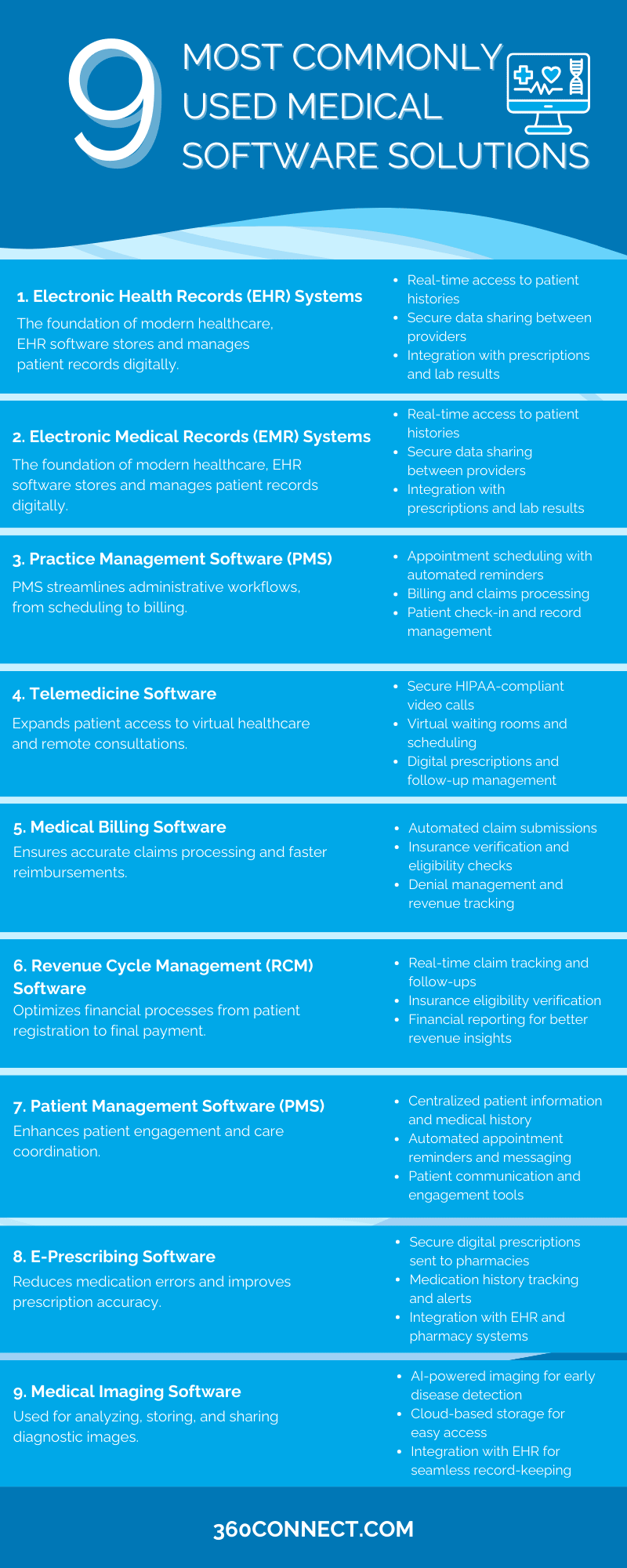In today’s healthcare landscape, technology plays a vital role in improving patient care, streamlining administrative tasks, and ensuring compliance with industry regulations. From small clinics to large hospitals, medical software solutions help providers manage everything from patient records to billing and scheduling.
But with so many options available, what is the most commonly used medical software? The answer depends on the specific needs of a healthcare facility. While some practices prioritize electronic health records (EHR) for efficient documentation, others rely heavily on medical billing software to ensure timely reimbursements.
This guide explores the most widely used medical software solutions, their benefits, and the top providers leading the industry.
The Role of Medical Software in Healthcare
Medical software has become an essential tool for healthcare providers, eliminating many of the inefficiencies that come with paper-based systems. Whether it’s tracking patient histories, submitting insurance claims, or scheduling appointments, medical software helps healthcare facilities operate more smoothly while improving patient outcomes.
These tools don’t just make life easier for providers, they also improve the overall patient experience by reducing wait times, enhancing communication, and ensuring seamless coordination between different departments.
Perhaps the most significant impact of medical software is on patient care. When providers have quick access to accurate, up-to-date medical records, they can make more informed treatment decisions.
In short, medical software is transforming the way healthcare is delivered, making it faster, safer, and more efficient for everyone involved.
What is the Most Commonly Used Medical Software?
While medical facilities use a variety of software programs, a few key solutions dominate the industry. The following categories represent the most commonly used medical software:

1. Electronic Health Records (EHR) Systems
EHR software is one of the most widely used solutions in healthcare. It serves as the backbone of medical documentation, allowing providers to maintain detailed patient records, track treatment progress, and share information with other healthcare professionals.
Indeed, a well-implemented EHR system improves accuracy, enhances communication, and reduces paperwork, ultimately leading to better patient care. Many EHR platforms integrate with billing and scheduling software, making them an all-in-one solution for healthcare providers.
As of 2021, nearly half of office-based physicians and almost all non-federal acute care hospitals use certified EHR.
Key Features:
- Digital patient records with real-time access.
- Integration with lab results, prescriptions, and imaging.
- Secure data sharing between healthcare providers.
- Customizable templates for faster documentation.
2. Electronic Medical Records (EMR) Systems
EMR software is one of the most commonly used medical technologies, designed to streamline documentation, improve patient care, and ensure regulatory compliance. Unlike traditional paper records, EMRs provide healthcare providers with a digital platform to store, track, and manage patient health information in real time.
Additionally, EMRs improve efficiency by reducing administrative burdens, minimizing human errors, and enhancing coordination between different healthcare professionals. Many EMR systems integrate with billing, scheduling, and reporting tools, allowing practices to manage multiple aspects of patient care from a single platform. With features such as automated alerts, e-prescribing, and customizable templates, EMRs help providers make data-driven decisions while optimizing workflows.
Key Features:
- Centralized patient records with real-time updates for improved care coordination.
- Customizable templates to streamline documentation and ensure accurate record-keeping.
- Automated alerts and reminders for medication interactions, allergies, and follow-ups.
- Interoperability to securely share patient data with other providers, labs, and pharmacies.
- Billing and coding integration to ensure accurate claims processing and minimize errors.
3. Practice Management Software (PMS)
While EHR software focuses on medical documentation, practice management software (PMS) handles the business side of healthcare. It helps providers manage appointments, streamline administrative tasks, and optimize workflow efficiency.
Indeed, a good PMS reduces the time spent on scheduling, billing, and paperwork, allowing healthcare providers to focus more on patient care. Additionally, many PMS solutions integrate with EHR and billing software to create a seamless experience.
Key Features:
- Appointment scheduling with automated reminders.
- Patient check-in and record management.
- Billing and claims processing.
- Reporting and analytics for practice performance.
4. Telemedicine Software
With the rise of virtual healthcare, telemedicine software has become an essential tool for medical providers. Namely, it enables physicians to conduct virtual consultations, prescribe medications, and monitor patients remotely.
Telemedicine software has grown in popularity due to its convenience, particularly for patients in rural or underserved areas. It allows providers to expand their reach and offer care beyond traditional in-person visits.
Related: Your Guide to Telehealth Solutions
Key Features:
- Secure video consultations with HIPAA compliance.
- Patient scheduling and virtual waiting rooms.
- Digital prescriptions and follow-up care.
- Integration with EHR systems.
5. Medical Billing Software
Managing billing and insurance claims is one of the most challenging aspects of running a healthcare practice. However, medical billing software simplifies the entire process by automating claims submission, verifying insurance eligibility, and tracking payments.
By reducing errors and ensuring timely reimbursements, billing software helps medical practices maintain healthy cash flow. Many solutions also include compliance tools to ensure practices adhere to HIPAA and insurance regulations.
Key Features:
- Automated claims processing and submission.
- Insurance verification and eligibility checks.
- Payment tracking and revenue cycle management.
- Denial management and claims follow-ups.
6. Revenue Cycle Management (RCM) Software
RCM software is crucial for optimizing the financial performance of healthcare organizations. Moreover, it manages the entire revenue cycle, from patient registration and insurance verification to claims processing and payment collection.
In addition, by integrating with EHR and billing systems, RCM software ensures that claims are submitted accurately, reducing denials and improving cash flow.
Key Features:
- End-to-end claims management and processing.
- Automated insurance eligibility verification.
- Payment collections and financial reporting tools.
- Analytics to track revenue trends and identify areas for improvement.
7. Patient Management Software (PMS)
Patient Management Software (also known as Patient Engagement Software) is designed to improve patient interactions and care coordination. It centralizes patient demographics, appointment scheduling, communication, and treatment history.
This type of software enhances the overall patient experience by streamlining administrative workflows and ensuring that healthcare providers have easy access to critical patient information.
Key Features:
- Centralized patient records and demographic tracking.
- Appointment scheduling with automated reminders.
- Patient communication tools (secure messaging, telehealth integration).
- Reporting and analytics for better patient engagement strategies.
8. E-Prescribing Software
E-Prescribing software enables healthcare providers to send digital prescriptions directly to pharmacies. Above all, this technology reduces medication errors, improves prescription adherence, and streamlines the prescribing process.
E-prescribing is now widely adopted across the healthcare industry, with regulations requiring electronic prescribing for controlled substances in many states.
94% of prescriptions filled in 2021 were e-prescriptions.
Key Features:
- Secure transmission of digital prescriptions to pharmacies.
- Medication history tracking and interaction alerts.
- Integration with EHR and pharmacy management systems.
- Compliance with electronic prescribing laws and regulations.
9. Medical Imaging Software
Medical Imaging Software is used to store, retrieve, and analyze diagnostic images, such as X-rays, MRIs, and CT scans. It allows radiologists and other healthcare providers to review and share images quickly and efficiently.
With the advancement of AI-powered imaging analysis, this software is now capable of detecting abnormalities, assisting in diagnoses, and improving clinical decision-making.
Key Features:
- Secure storage and retrieval of diagnostic images.
- AI-powered image analysis for early disease detection.
- Integration with EHR systems for seamless record-keeping.
- Cloud-based solutions for remote access and tele-radiology.
Who Can Benefit From Medical Software?
While nearly every medical facility can benefit from technology, certain providers rely on medical software to optimize operations and improve patient care. Some of the key groups include:
- Hospitals
- Private Practices & Clinics
- Dentists
- OBGYN Practices
- Physical Therapists & Rehabilitation Centers
- Mental Health Providers
Each of these providers faces unique challenges, and the right medical software helps them overcome administrative burdens, enhance patient care, and improve financial performance.
What is the Most Commonly Used Medical Software? — Top Medical Software Providers
Choosing the right medical software provider is crucial for improving efficiency and ensuring seamless healthcare operations. Therefore, here are some of the most widely used providers:
Athena Health
Athenahealth offers a cloud-based EHR and medical billing platform tailored for small to mid-sized practices. In addition, it’s known for its user-friendly interface, easy implementation, and built-in billing automation tools. Athenahealth’s network-driven approach allows providers to stay updated with regulatory changes and payer guidelines in real time, reducing claim denials and billing errors.
Best for:
- Small to mid-sized medical practices
- Providers looking for a simple, cloud-based EHR
- Clinics needing integrated billing and scheduling solutions
DrChrono
DrChrono combines EHR, practice management, and medical billing into a single, customizable platform. Indeed, it is a mobile-friendly solution that offers an intuitive iPad app for on-the-go charting, e-prescribing, and patient check-ins. With features like voice recognition for note-taking and real-time insurance eligibility verification, DrChrono is an excellent choice for tech-savvy practices.
Best for:
- Small practices and independent providers
- Clinics needing a mobile-first EHR solution
- Providers looking for integrated telemedicine capabilities
AdvancedMD
AdvancedMD is a fully integrated medical software provider offering EHR, billing, scheduling, and telemedicine solutions. Moreover, it features AI-driven automation to improve workflow efficiency and reduce administrative burdens. With customizable templates and real-time analytics, AdvancedMD helps providers optimize revenue cycle management while maintaining compliance.
Best for:
- Mid-sized to large healthcare practices
- Providers needing AI-driven workflow automation
- Organizations looking for a comprehensive all-in-one platform
Epic Systems
Epic is one of the most widely used medical software providers, particularly in large hospital systems and healthcare networks. It offers a highly customizable platform with extensive interoperability, allowing seamless data exchange between healthcare providers, pharmacies, and labs. In addition, Epic is known for its robust patient portal, advanced analytics, and telehealth integration, making it a powerful all-in-one solution.
Best for:
- Large hospital systems and healthcare organizations
- Providers needing a fully integrated patient portal
- Facilities requiring extensive interoperability
Final Thoughts on What is the Most Commonly Used Medical Software?
Overall, medical software plays a vital role in modern healthcare, improving efficiency, reducing errors, and enhancing patient care. From EHR systems to telemedicine platforms, the right software solution can streamline operations and make life easier for both providers and patients.
If you’re wondering what the most commonly used medical software is, the answer depends on the needs of your practice. Whether you need a robust EHR system, a practice management solution, or reliable billing software, choosing the right provider is key to optimizing your operations.
Get Free Medical Software Quotes
Looking for the right medical software for your practice? 360Connect can help! Get free quotes from top-rated providers and find the right solution for your needs.

